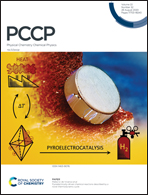Extending the vibrational lifetime of azides with heavy atoms†
Abstract
The development of novel vibrational reporters (VRs), aka infrared (IR) probes, to study local environments and dynamic processes in biomolecules and materials continues to be an important area of research. Azides are important VRs because of their small size and large transition dipole strengths, however, their relatively short vibrational lifetimes (<2 ps) have limited their full potential. Herein we report that the vibrational lifetimes of azides can be increased by attaching them to heavy atoms and by using heavy 15N isotopes. Three group 14 atom triphenyl azides (Ph3CN3, Ph3SiN3, Ph3SnN3), and their triple-15N isotopomers, were synthesized in good yields. Tributyltin azide and its heavy isotopomer (Bu3Sn15N3) were also prepared to probe the effect of molecular scaffolding. The extinction coefficients for the natural abundance azides were determined, ranging from 900 to 1500 M−1 cm−1. The vibrational lifetimes of all azides were measured by pump–probe IR spectroscopy and each showed a major component with a short-to-moderate vibrational lifetime and a minor component with a much longer vibrational lifetime. Based on these results, the lifetime, aka the observation window, of an azide reporter can be extended from ∼2 ps to as long as ∼300 ps by a combination of isotopic labeling and heavy atom effect. 2D IR measurements of these compounds further confirmed the ability to observe these azide transitions at much longer timescales showing their utility to capture dynamic processes from tens to hundreds of picoseconds.



 Please wait while we load your content...
Please wait while we load your content...